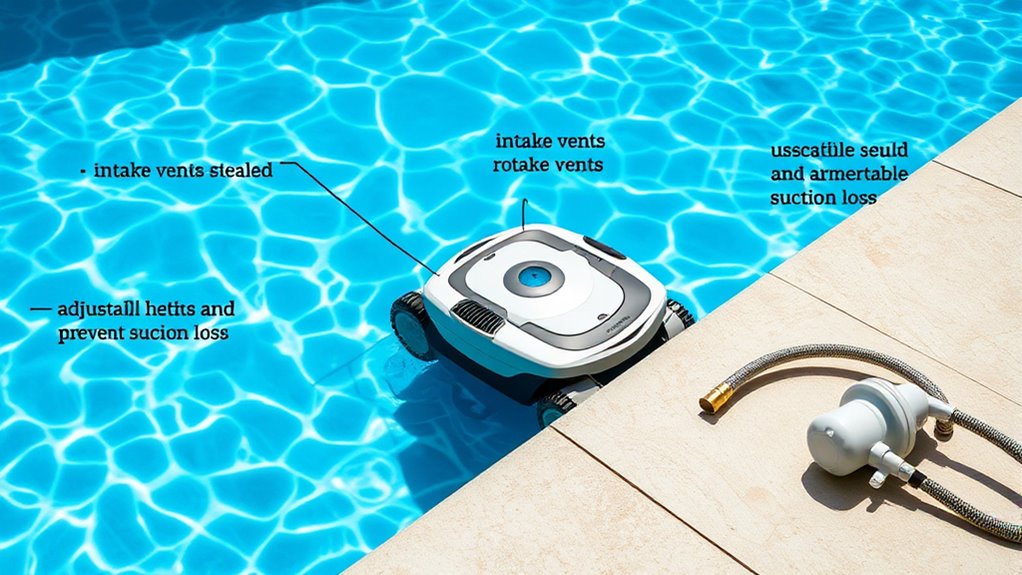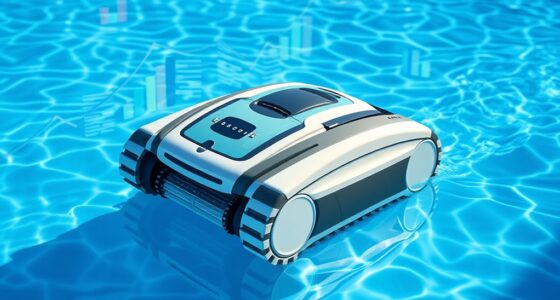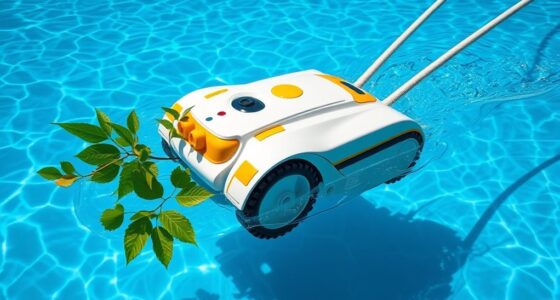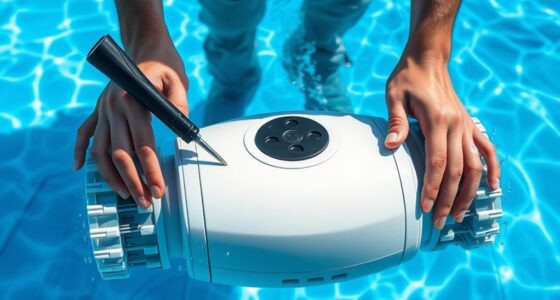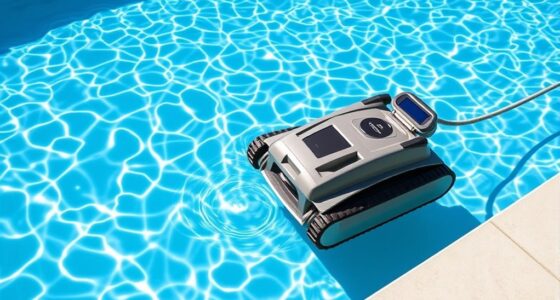To prevent suction loss in your pool cleaner, regularly inspect and clean your skimmer and pump baskets to remove debris. Make sure all hoses and fittings are tight and free of cracks or tears. Position your cleaner properly in the pool, away from obstructions, and adjust the flow rate for maximum performance. Routine maintenance of filters, seals, and impellers helps keep water flow steady. Continuing these tips ensures your cleaner works efficiently and longer.
Key Takeaways
- Regularly inspect and clean skimmer baskets, filters, and pump components to prevent debris blockages and maintain proper water flow.
- Ensure all hose fittings and connections are tight, secure, and free of cracks or leaks to prevent air leaks and suction loss.
- Position the pool cleaner centrally and remove obstructions to ensure even movement and optimal suction.
- Adjust and monitor flow rates and prime the pump correctly to maintain strong, consistent suction during cleaning.
- Perform routine maintenance and replace worn parts promptly to preserve system integrity and prevent suction issues.
Check and Clear the Skimmer Basket
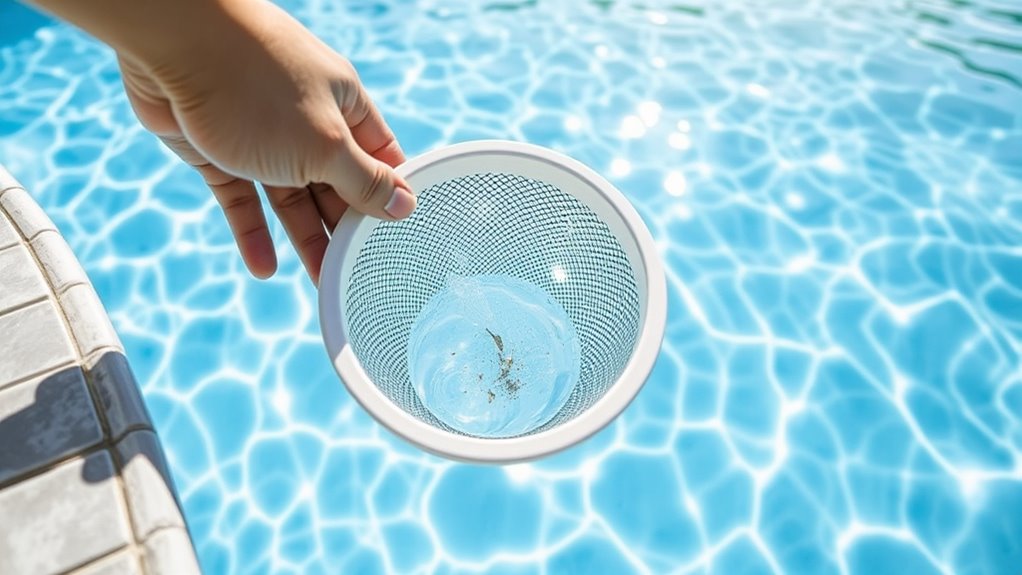
To prevent suction loss, it’s essential to regularly check and clear the skimmer basket. A clogged skimmer basket restricts water flow, making it harder for your pool cleaner to operate efficiently. Start by turning off the pool pump and removing the basket. Inspect it for debris such as leaves, twigs, or dirt that may have accumulated. Use your hands or a brush to remove debris thoroughly, ensuring no blockages remain. Once cleaned, replace the basket securely before turning the pump back on. Regular debris removal from the skimmer basket keeps water flowing smoothly and prevents suction loss. Additionally, understanding the importance of water flow management can help maintain optimal pool cleaner performance. Properly maintaining the canvas and seals of your pool equipment can also prevent leaks and improve efficiency. Ensuring the skimmer basket is free of debris and in good condition is crucial for maintaining proper water circulation and avoiding suction issues. By maintaining a clean skimmer basket, you help your pool cleaner perform ideally and avoid common issues caused by restricted water flow.
Inspect and Clean the Pool Pump Basket
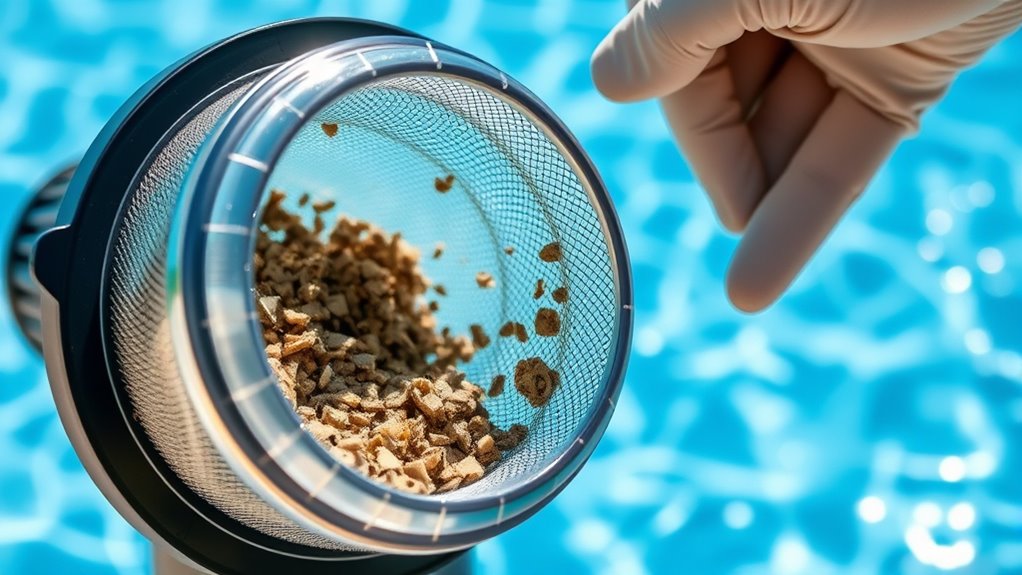
You should regularly inspect your pool pump basket to guarantee it’s free of debris and blockages. Clean it thoroughly to maintain proper water flow and prevent suction issues. If you notice any damaged components, replace them promptly to avoid future problems. Additionally, understanding the trust issues in your relationship can help you better address underlying problems that may affect your overall pool maintenance routine. Regularly using airless paint sprayers for maintenance tasks can also ensure efficient cleaning and upkeep of your pool equipment. Incorporating proper water chemistry checks can further improve the longevity and performance of your pool system. Proper filter maintenance is essential to prevent debris buildup and maintain optimal suction.
Regular Basket Inspection
Regularly inspecting and cleaning your pool pump basket is essential for preventing suction loss. A clean basket ensures unobstructed water flow, which helps your pool cleaner operate efficiently. Check the basket frequently, especially if you notice reduced suction or debris buildup. Keep in mind that proper chemical balance and water temperature can impact debris accumulation and how often you need to inspect. If your water is unbalanced, it may cause more debris to stick or break apart, clogging the basket. Conversely, higher water temperatures can accelerate algae growth and debris decay, increasing the need for regular inspections. Maintaining a clean basket prevents blockages that could lead to suction loss, ensuring your pool cleaner works smoothly and extends its lifespan. Additionally, understanding water quality and its effects can help you optimize your pool maintenance routine. Regularly monitoring chemical levels can further prevent debris buildup and maintain optimal water clarity. Ensuring proper filtration system operation also plays a critical role in maintaining consistent suction and overall pool health.
Proper Basket Cleaning
A clean pool pump basket is essential for maintaining proper water flow and preventing suction loss. Regularly inspecting and cleaning the basket guarantees debris doesn’t restrict water movement. To do this effectively:
- Turn off the pump and remove the basket, checking for debris like leaves or dirt.
- Rinse the basket thoroughly with a hose, paying attention to corners and crevices.
- While cleaning, inspect the basket for cracks or damage, replacing if necessary.
Replace Damaged Components
Inspecting and cleaning the pool pump basket helps keep water flowing smoothly, but over time, damage can occur that impairs its function. Damaged seals can cause leaks, reducing suction and efficiency. Worn impellers may become less effective at circulating water, leading to suction loss. Regularly check for cracks, tears, or corrosion in seals and replace them promptly to prevent leaks. If you notice the impeller is chipped or worn, replacing it ensures proper water flow and maintains suction. Ignoring these issues can cause your pool cleaner to lose suction, increasing strain on the pump and decreasing cleaning performance. Utilizing automation in your maintenance routine can help identify potential problems early. Proper preventive maintenance and timely replacements can extend the lifespan of your pool equipment and keep your cleaner functioning properly. Additionally, understanding the contrast ratio of your pump and component compatibility can help prevent inefficiencies. Being aware of the component compatibility ensures that replacement parts fit properly and function as intended. By replacing damaged components as needed, you keep your pool cleaner functioning properly and prevent unnecessary breakdowns. Regular inspections and component compatibility checks are essential for optimal operation.
Examine and Replace Damaged Hoses and Connections
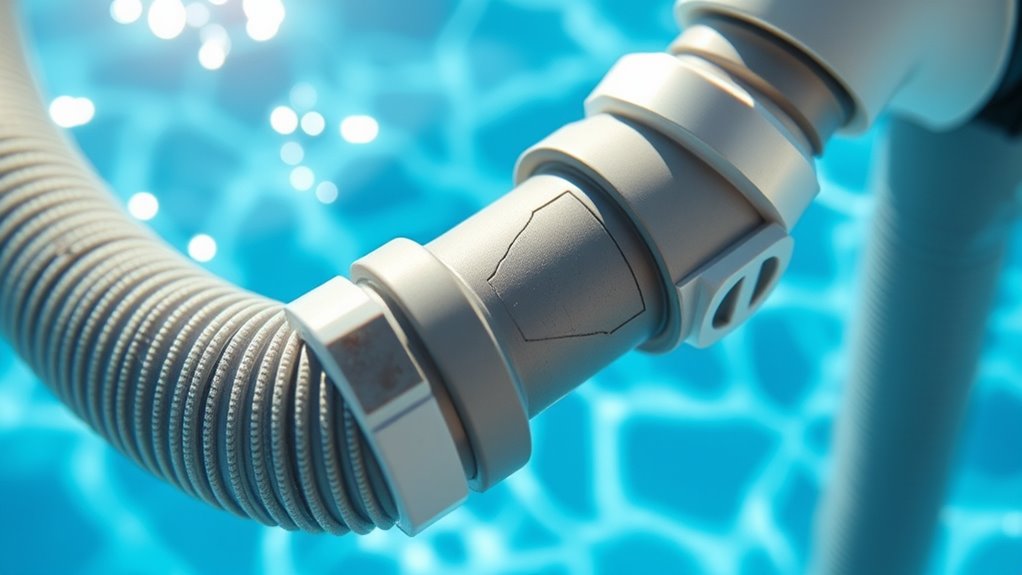
Check your hoses for cracks or tears that could cause leaks. Make sure all fittings are tight and secure to maintain proper suction. Replacing damaged hoses or loose connections helps keep your pool cleaner working efficiently.
Inspect for Cracks or Tears
Over time, cracks and tears can develop in your pool cleaner’s hoses and connections, leading to suction loss. Regular crack detection is essential to catch damage early. To inspect effectively:
- Examine hoses closely for visible cracks or holes, especially at connection points.
- Check for soft or brittle areas indicating wear, which may tear easily.
- Test connections for leaks or looseness, ensuring a secure fit.
- Consider the dog names you might assign to your pool cleaner, as giving it a friendly name can make maintenance checks more engaging. Additionally, inspecting the integrity of the hoses regularly helps prevent more significant issues and extends the lifespan of your equipment. Regular maintenance and early detection of damaged hoses can significantly improve your pool cleaner’s efficiency. It’s also helpful to familiarize yourself with common hose repair techniques so you can address minor damages promptly. Staying informed about local repair resources can also be beneficial if professional assistance is needed.
If you find any cracks, perform tear repair promptly using appropriate repair kits or replacement parts. Damaged hoses reduce suction power, so addressing issues quickly maintains ideal cleaning performance. Always replace severely damaged hoses or connections to prevent further leakages, ensuring your pool cleaner functions efficiently and prolongs its lifespan.
Ensure Tight Hose Fittings
Regularly guarantee hose fittings are tight and secure to maintain peak suction. Loose hose connections can cause air leaks, reducing your pool cleaner’s efficiency. Check all hose connections before each use, ensuring fitting tightness is consistent. If you notice any leaks or if fittings feel loose, tighten them firmly but avoid over-tightening, which can damage the fittings. Damaged or cracked hoses and fittings compromise suction and should be replaced immediately. Examine hoses for cracks, tears, or brittleness, and replace any compromised sections to prevent leaks. Properly connected and secure hose fittings ensure consistent suction, allowing your pool cleaner to operate effectively. Proper maintenance practices are essential for preventing common issues and extending its lifespan. Additionally, effective inspections can help identify potential problems before they impact performance, saving time and money. Taking these steps minimizes suction loss and prolongs the life of your cleaning equipment.
Ensure Proper Placement of the Pool Cleaner
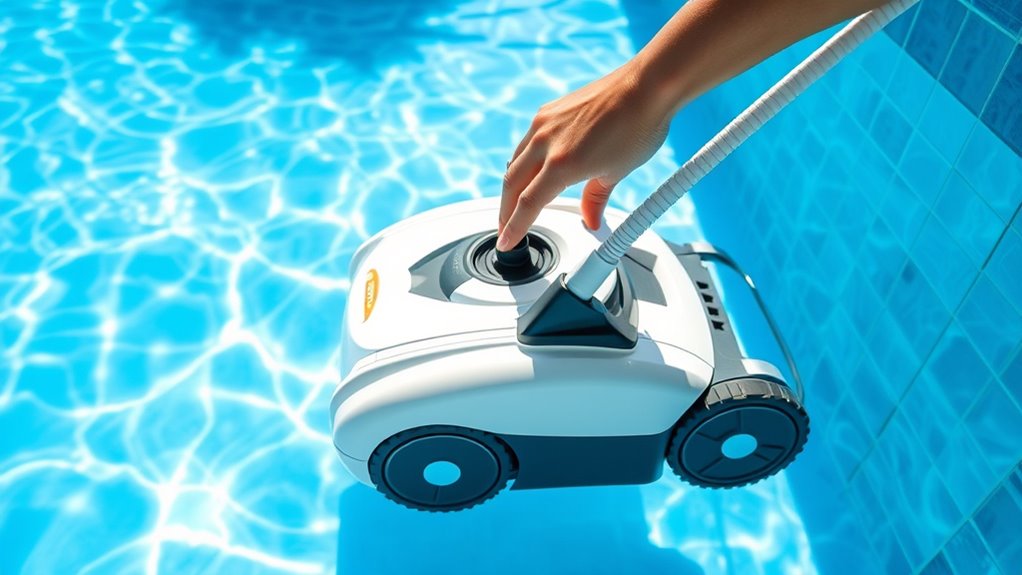
To prevent suction loss, you need to make sure your pool cleaner is positioned correctly. Proper pool cleaner positioning ensures ideal placement, allowing the cleaner to operate efficiently. Here’s what to focus on:
Ensure your pool cleaner is centered, unobstructed, and on a smooth surface for optimal suction and efficiency.
- Start at the Center: Place the cleaner in the middle of the pool for even coverage and better suction.
- Check for Obstructions: Remove any debris or obstructions that could interfere with the cleaner’s movement and flow.
- Maintain a Flat Surface: Ensure the pool floor is smooth and level, promoting ideal placement and preventing suction loss.
Adjust the Pool Cleaner’s Flow Rate Settings
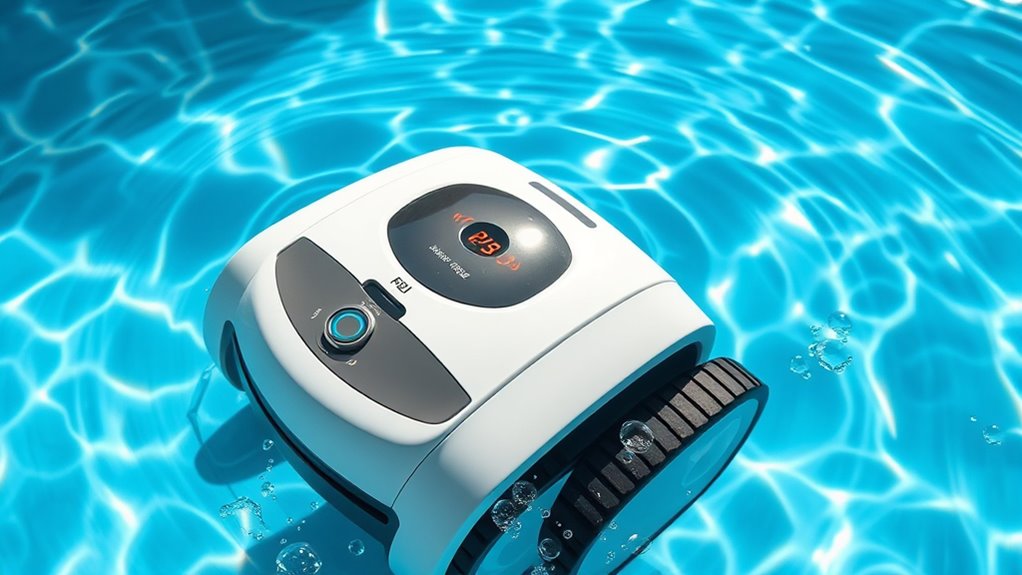
You can improve your pool cleaner’s performance by adjusting its flow rate settings. Setting the right flow guarantees it cleans efficiently without losing suction. Fine-tuning this helps the cleaner grip surfaces better and operates smoothly.
Optimize Flow for Efficiency
Adjusting your pool cleaner’s flow rate settings is crucial for maximizing its efficiency and preventing suction loss. Proper flow optimization ensures your cleaner operates smoothly and conserves energy. Follow these efficiency tips:
- Set the flow rate according to your pool size—larger pools need higher settings, while smaller pools require lower flow to prevent overloading.
- Monitor the suction pressure regularly—if it’s too high or low, tweak the flow to maintain ideal performance.
- Use the manufacturer’s recommended settings as a baseline—adjust gradually to find the perfect spot for your specific pool conditions.
Fine-Tune for Better Grip
Fine-tuning your pool cleaner’s flow rate settings can substantially improve its grip on surfaces and prevent suction loss. By adjusting the flow, you enhance grip enhancement, ensuring the cleaner maintains contact with pool walls and floors. Increasing the flow rate boosts traction improvement, helping the cleaner stay in place during cleaning cycles. Conversely, lowering the flow might reduce unnecessary strain on the motor and improve overall stability. Check your manufacturer’s guidelines to find the best flow rate for your specific model. Small adjustments can make a big difference in maintaining consistent suction and preventing slippage. Regularly fine-tuning these settings ensures your cleaner maximizes surface contact, providing efficient cleaning without losing grip or traction.
Prime the Pool Pump and Filter System
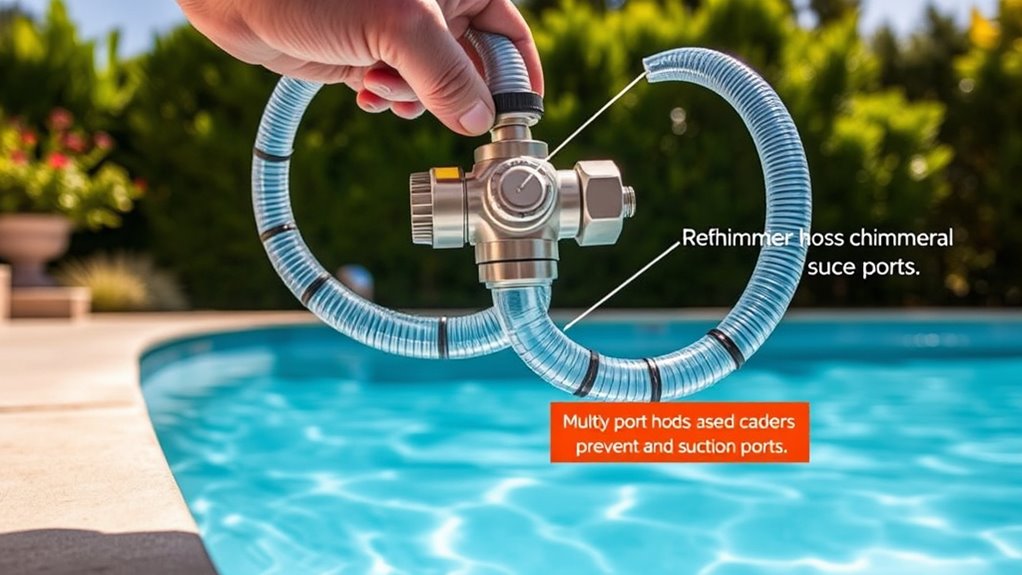
To guarantee your pool cleaner operates smoothly, it’s essential to properly prime the pool pump and filter system before use. Proper pump priming ensures there’s no air trapped inside, which can cause suction loss. First, check for debris accumulation around the skimmer and pump basket, clearing any blockages. Next, fill the pump basket with water to eliminate air pockets. Finally, follow these steps:
Properly priming your pool pump prevents air entrapment and ensures smooth, effective cleaning.
- Turn off the pump and open the air release valve to vent trapped air.
- Prime the pump by filling it with water if it’s not self-priming.
- Restart the pump, observing for consistent, strong suction.
This process prevents air from entering the system, maintaining peak flow and avoiding suction loss during cleaning.
Remove Obstructions From the Pool’S Intake and Return Lines
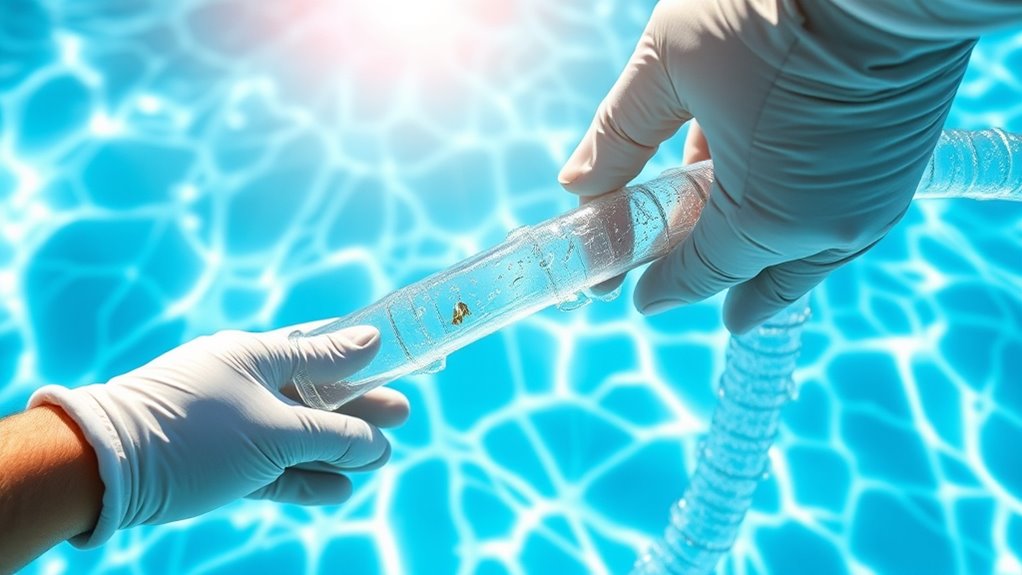
Obstructions in your pool’s intake and return lines can disrupt water flow and cause suction loss, so it’s important to check and clear them regularly. Start with debris removal—inspect the lines for leaves, dirt, or other blockages that could hamper water movement. Conduct a thorough line inspection to identify any cracks, obstructions, or buildup that may be restricting flow. Use a hose or a line cleaning tool to flush out debris or clear minor blockages. If you notice persistent issues, consider removing and cleaning the intake and return fittings. Regular maintenance ensures smooth water flow, preventing suction loss and keeping your pool cleaner and functioning efficiently. Staying proactive with debris removal and line inspection is key to avoiding flow disruptions.
Regularly Maintain and Clean the Pool Filter
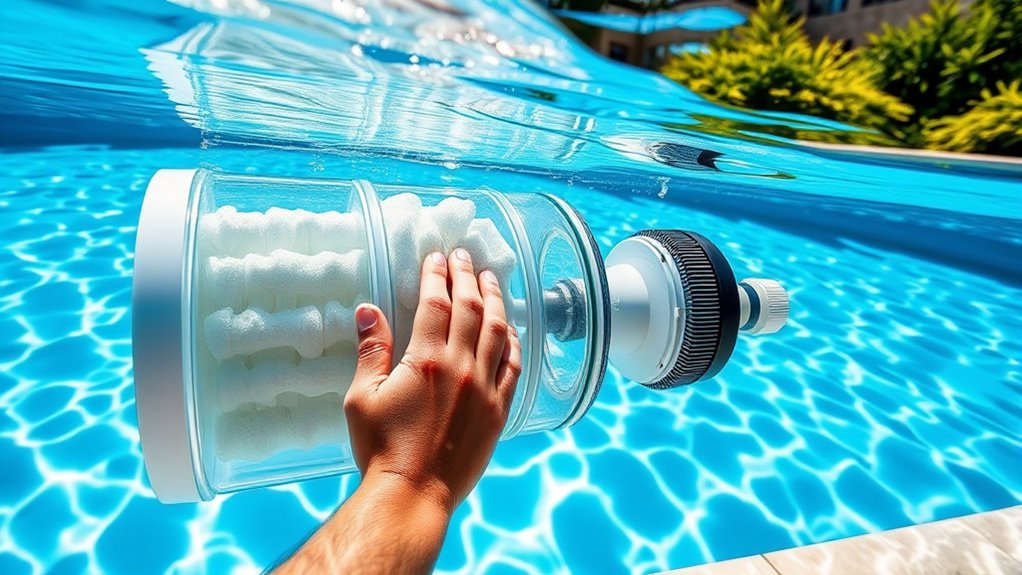
Regularly maintaining and cleaning your pool filter plays a vital role in preventing suction loss. A clean filter guarantees ideal water flow, reducing strain on your pool cleaner. To keep it in top shape, consider these steps:
Keep your pool flowing smoothly by regularly cleaning and maintaining your filter.
- Inspect and replace the filter when it becomes worn or clogged to maintain proper suction.
- Clean the filter regularly, following manufacturer instructions, to remove debris and prevent blockages.
- Confirm chemical balancing in your pool to prevent buildup of residues that can clog the filter and affect performance.
Verify the Condition of the Pool Cleaner’s Seal and Impeller
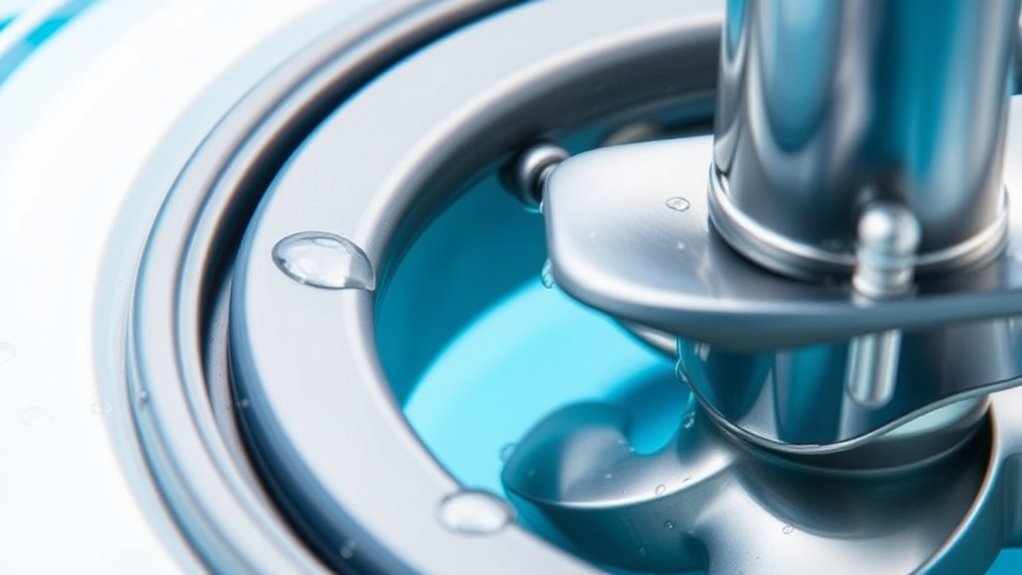
Ensuring the pool cleaner’s seal and impeller are in good condition is essential for maintaining peak suction. Check the seal integrity regularly—any cracks or wear can cause leaks, reducing suction power. The impeller’s function is equally critical; a damaged or jammed impeller hampers water flow, decreasing cleaning efficiency.
Reflect on the following to gauge your cleaner’s health:
| Condition | Effect on Seal & Impeller | Emotional Impact |
|---|---|---|
| Good | Ideal performance | Confidence and peace of mind |
| Slight wear | Slight loss of suction | Frustration, but manageable |
| Cracks or leaks | Reduced seal integrity | Anxiety, potential damage |
| Impeller jammed | Impaired impeller function | Disappointment, worry |
| Severe damage | Complete failure | Stress, urgent repair needed |
Schedule Routine Professional Inspection and Maintenance
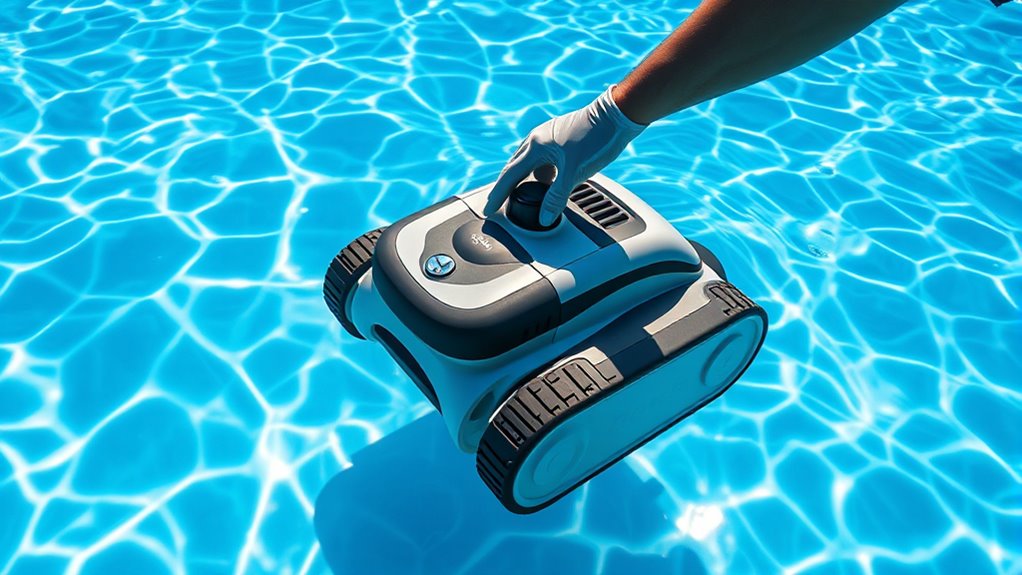
Scheduling routine professional inspections and maintenance is crucial to keep your pool cleaner operating at its best. Regular checkups ensure your equipment stays in top condition, helping prevent suction loss caused by unseen issues. During these visits, professionals evaluate key aspects such as:
Routine professional inspections ensure optimal pool cleaner performance and prevent suction issues.
- Pool chemistry balance, which reduces buildup that can clog the cleaner’s components.
- Algae prevention measures, ensuring your pool remains free of algae that may interfere with suction.
- Component integrity, including seals, hoses, and filters, to catch wear and tear early.
Timely maintenance keeps your pool cleaner running smoothly and extends its lifespan. It also minimizes unscheduled repairs, saving you time and money in the long run. Prioritize professional inspections to maintain ideal suction and enjoy a cleaner, healthier pool.
Frequently Asked Questions
How Often Should I Replace My Pool Cleaner’S Seal?
You’re wondering how often to replace your pool cleaner’s seal. For effective pool cleaner maintenance, inspect the seal regularly for cracks, wear, or leaks. Generally, seal replacement frequency depends on usage and water conditions, but most owners should check it every 3 to 6 months. If you notice reduced suction or leaks, it’s time to replace the seal promptly to keep your cleaner working efficiently and prevent further issues.
What Are Signs My Pool Pump Needs Repair?
Your pool pump’s signs are a red flag, like a warning siren blaring in the night. If you notice decreased water flow, strange noises, or your pool isn’t heating properly, it’s time for pool pump maintenance. These issues can lead to algae buildup and poor filtration. Addressing repairs early keeps your pool crystal clear and prevents costly fixes, ensuring your pool stays inviting and algae-free all season long.
Can Algae Buildup Cause Suction Issues?
Algae buildup can definitely cause suction issues in your pool cleaner. When algae forms an algae blockage or debris accumulates inside the skimmer or hoses, it restricts water flow. This reduced flow leads to suction loss, making your cleaner less effective. To prevent this, regularly clean your skimmer and filter, and treat your pool to control algae growth. Proper maintenance keeps water flow steady and your cleaner functioning smoothly.
Are There Specific Hose Types Best for Suction Stability?
You’re wondering if certain hose types improve suction stability. Opt for hoses made from durable, flexible materials like reinforced vinyl or rubber, which resist kinks and maintain steady suction. Also, check the hose diameter; larger diameters allow better water flow and reduce pressure drops. Using the right hose material and size guarantees your pool cleaner operates smoothly without losing suction, keeping your pool clean and well-maintained.
How Do I Troubleshoot Inconsistent Cleaner Movement?
If your pool cleaner moves inconsistently, start troubleshooting by checking for robotic navigation issues. Confirm the cleaner’s sensors and wheels aren’t obstructed, as debris obstruction can hinder smooth movement. Clear any debris around the robot and along its path, and verify that the navigation system isn’t blocked or dirty. Also, inspect hoses and connections for leaks or kinks, which can affect suction and overall movement.
Conclusion
By regularly inspecting your skimmer basket, hoses, and filters, you can prevent suction loss and keep your pool cleaner running smoothly. Many believe that maintaining proper flow rates alone solves the problem, but it’s actually a combination of steps. Consistent upkeep and checking for obstructions ensure peak performance. Think of it like keeping your car well-tuned—small, routine checks make a big difference in preventing pool cleaning issues and extending your equipment’s lifespan.
